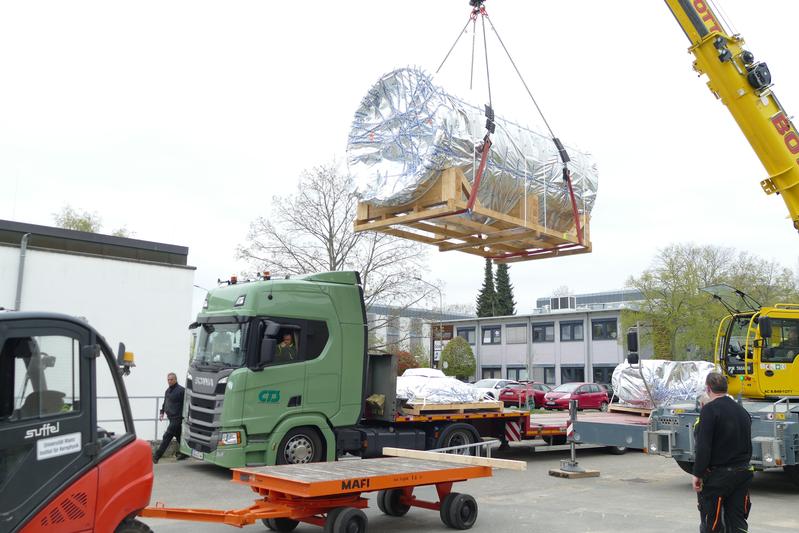Vacuum chamber weighing several tons delivered for the MESA particle accelerator
High technology enables unique experiment for new physics research on the campus of Johannes Gutenberg University Mainz
The construction of the new energy-recovery particle accelerator MESA (Mainz Energy-recovery Accelerator) at Johannes Gutenberg University Mainz (JGU) continues to progress. Following the installation of a 21-ton superconducting magnet last November, a vacuum chamber weighing 3.3 tons was delivered to MESA today. The MESA accelerator is one of the outstanding projects of the PRISMA+ Cluster of Excellence in Mainz and offers new, unique opportunities for fundamental research in physics. It is composed of two main experiments: MAGIX and P2. They are to provide significant contributions to research into the “new physics” - physics beyond the Standard Model.
The P2 experiment is now supplemented by the delivery of the vacuum chamber. P2 is intended to answer previously unsolved questions in the field of elementary particle physics by measuring the so-called weak mixing angle. This requires extremely precise measurements, for which each individual component of the experiment, such as the new vacuum chamber, must be designed and manufactured with the utmost care.
“Although the vacuum chamber looks inconspicuous at first glance - like a simple aluminum barrel - it is a piece of high technology,” says Prof. Frank Maas, spokesperson for the P2 experiment. The component has a length of seven meters, a diameter of 2.4 meters and a total volume of 32 cubic meters. It creates the extremely demanding conditions of the P2 experiment: in the front part, the chamber provides the vacuum required to operate the target cell at around minus 257 degrees Celsius. The target cell is the container that holds the sample at which the electron beam is fired. The sample container and the entire cooling system contain approximately 70 liters of liquid hydrogen, with the vacuum serving as insulation and preventing heat exchange through convection. When the MESA electron beam hits the target cell, it generates heat which must be dissipated through a helium cooler. Helium gas also surrounds the silicon pixel detector at the rear of the chamber, which measures the momentum of the electrons interacting with the target.
Another remarkable detail is the vacuum window, which is installed between the front and rear parts of the vacuum chamber. It is made of carbon fiber-reinforced epoxy resin and is bonded to an aluminum flange. It ensures a stable structure with the lowest possible thickness, which meets the high requirements of the experimental conditions. The vacuum chamber itself is made of a high-strength aluminum alloy and is fitted with special metal seals to ensure that it can withstand the extreme radiation conditions. “In addition, the chamber must fit into the superconducting magnet and therefore be very round. NTG in Gelnhausen is one of the few companies that can produce such a device,” says Prof. Frank Maas.
The development work on the P2 experiment and its construction have been funded by the PRISMA+ Cluster of Excellence and the German Research Foundation's large-scale equipment program, among others.
Wissenschaftlicher Ansprechpartner:
Prof. Dr. Frank Maas
Institute for Nuclear Physics/ Exzellenzcluster PRISMA+
Johannes Gutenberg-Universität Mainz
55099 Mainz
E-Mail: maas@him.uni-mainz.de
https://www.kernphysik.uni-mainz.de/univ-prof-dr-frank-maas/
Weitere Informationen:
https://www.blogs.uni-mainz.de/fb08p2/ – P2-Experiment
https://www.prisma.uni-mainz.de – Exzellenzcluster PRISMA+
https://www.helmholtz.de/en/newsroom/article/illuminating-the-nature-of-dark-matter-through-precision/ – Article of the Helmholtz-Gemeinschaft „Illuminating the Nature of Dark Matter Through Precision”
https://download.uni-mainz.de/presse/08_prisma+_vakuumkammer.JPG - Image (original size)
Die semantisch ähnlichsten Pressemitteilungen im idw


